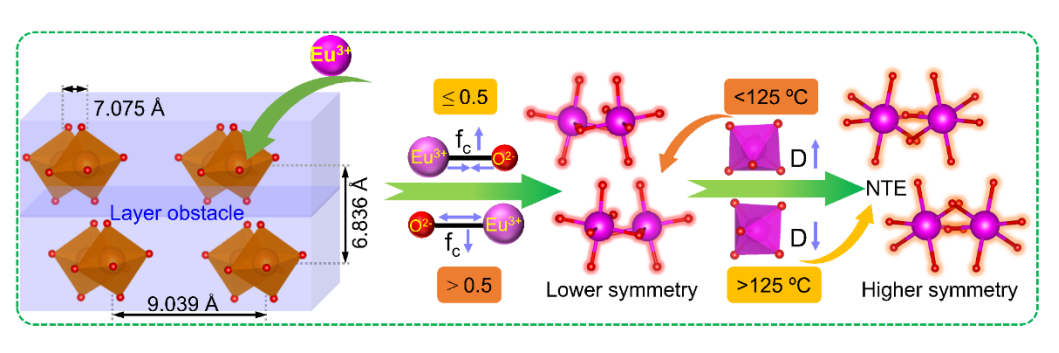Phosphor-converted white light-emitting diodes (pc-WLEDs) have become the next-generation solid-state lighting source owing to their energy conservation, high efficiency, long durability and environmental friendliness. Red phosphor materials play a key role in improving the lighting quality of phosphor-converted white light-emitting diodes (pc-WLEDs). However, the design of new red-emitting phosphors excited by n-UV or blue light with low thermal quenching and a high quantum efficiency (QE) under moderate synthesis conditions is a key challenge for emerging applications. To obtain red phosphor with outstanding properties, Eu3+-doped red phosphors have attracted much interest. Nevertheless, the weak and narrow absorption in the n-UV and blue regions in most Eu3+-doped phosphors due to the parity forbidden transitions (7F0 → 5D4, 5L6, 5D3) leads to a low QE, which and renders their application in n-UV-based pc-WLEDs difficult. In addition, as for the inorganic luminescent materials, most of them will be thermally quenched at higher temperature, which reduces the luminescence efficiency and affects the overall working efficiency of pc-WLEDs. Therefore, regulating the thermal stability of materials and exploring the internal mechanism of the changes in the photoluminescence (PL) properties of luminescent materials in a variable temperature environment are meaningful for the research and development of new luminescent materials.
Recently, Prof. Guogang Li’s group has developed a non-concentration quenching red Cs3EuGe3O9 phosphor with remarkable negative thermal expansion (NTE) properties. Under n-UV or blue light excitation, this phosphor exhibits a highly efficient red emission at 611 nm and high internal quantum efficiency (IQE = 94%), with good thermal stability (175-250 °C, > 90%). A pc-WLED device is constructed using red phosphor, emitting warm white light with colour coordinates (0.364, 0.383), a high colour rendering index (CRI = 89.7), and a low colour coordinate temperature (CCT = 4508 K). This work represents an important step towards achieving highly efficient and thermally stable red emission for solid-state illumination and backlit displays.

Figure 1. Schematic illustration of the effect of the crystal structure on the non-concentration quenching and temperature-dependent photoluminescence properties.
The authors explained the crystal structure of Cs3GdGe3O9 as a layered structure, the Gd3+ ions are separated by the Cs+ ions layer by layer along the c-axis. In this structure, such a layer-built lattice could provide a “layer obstacle” to restrict the interlayer energy migration of Eu3+ ions and then greatly reduce the possibility of the quenching centres capturing the effective energy, even at a Eu3+ concentration of 100%. In addition, the smaller lattice distortion of the [EuO6] octahedron leads to the higher symmetry of [EuO6] in the high-temperature region (> 150 °C), meaning a better thermal stability. Consequently, this non-concentration quenching red phosphor has good thermal stability in the high-temperature region. In this work, based on the microscopic crystal structure feature, the mechanism of the phenomenon of non-concentration quenching and negative thermal expansion induced high thermal stability is revealed. The unique non-concentration quenching is developed to achieve a highly efficient red phosphor. This red phosphor shows a high internal quantum efficiency of 94%, and good thermal stability based on the remarkable negative thermal expansion. It has great potential as a red component for pc-WLEDs, opening a new perspective for developing new phosphor materials.
This work was recently published in the Light: Science & Applications (titled “Thermally stable and highly efficient red-emitting Eu3+-doped Cs3GdGe3O9 phosphors for WLEDs: non-concentration quenching and negative thermal expansion”, DOI: 10.1038/s41377-021-00469-x). The first author is Dr. Peipei Dang and the corresponding authors are Professors Guogang Li and Jun Lin. This research was funded in part by the National Natural Science Foundation of China and the Key Research Program of Frontier Sciences, CAS.
Original link for the paper: https://doi.org/10.1038/s41377-021-00469-x